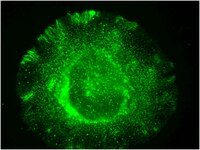NADPH oxidase NOX4 mediates stellate cell activation and hepatocyte cell death during liver fibrosis development.
Sancho, Patricia, et al.
PLoS ONE, 7: e45285 (2012)
2012
Show Abstract
A role for the NADPH oxidases NOX1 and NOX2 in liver fibrosis has been proposed, but the implication of NOX4 is poorly understood yet. The aim of this work was to study the functional role of NOX4 in different cell populations implicated in liver fibrosis: hepatic stellate cells (HSC), myofibroblats (MFBs) and hepatocytes. Two different mice models that develop spontaneous fibrosis (Mdr2(-/-)/p19(ARF-/-), Stat3(Δhc)/Mdr2(-/-)) and a model of experimental induced fibrosis (CCl(4)) were used. In addition, gene expression in biopsies from chronic hepatitis C virus (HCV) patients or non-fibrotic liver samples was analyzed. Results have indicated that NOX4 expression was increased in the livers of all animal models, concomitantly with fibrosis development and TGF-β pathway activation. In vitro TGF-β-treated HSC increased NOX4 expression correlating with transdifferentiation to MFBs. Knockdown experiments revealed that NOX4 downstream TGF-β is necessary for HSC activation as well as for the maintenance of the MFB phenotype. NOX4 was not necessary for TGF-β-induced epithelial-mesenchymal transition (EMT), but was required for TGF-β-induced apoptosis in hepatocytes. Finally, NOX4 expression was elevated in patients with hepatitis C virus (HCV)-derived fibrosis, increasing along the fibrosis degree. In summary, fibrosis progression both in vitro and in vivo (animal models and patients) is accompanied by increased NOX4 expression, which mediates acquisition and maintenance of the MFB phenotype, as well as TGF-β-induced death of hepatocytes. | 23049784
 |
Photocoagulation of human plasma: acyl serine proteinase photochemistry.
Porter, N A and Bruhnke, J D
Photochem. Photobiol., 51: 37-43 (1990)
1990
Show Abstract
Human alpha-thrombin or bovine Factor Xa was acylated at the active site serine hydroxyl with alpha-methyl-2-hydroxy-4-diethylaminocinnamic acid. These modified serine proteinase enzymes showed no plasma coagulation biological activity in the absence of light. Photolysis of the acyl serine proteinase enzymes in plasma for 1-35 s with monochromatic 366 nm light isolated from a high pressure mercury arc results in coagulation of the plasma. For example, photolysis of 3 NIH U of the acyl human alpha-thrombin for 5 s in human plasma results in a clot in 23 s. For comparison, 1 NIH U of unmodified human alpha-thrombin gave a clot in 21 s under the conditions of the assay but without photolysis. Appropriate controls showed that the coagulation is the result of the formation of active thrombin due to photodeacylation of the enzymes. The photoinduced clotting time measured is dependent on acyl thrombin concentration and photolysis time. Thus higher concentrations of acyl thrombin and longer photolysis times give a shorter clotting time. A kinetic scheme based upon Lineweaver-Burke analysis of the clotting process is developed. | 2304978
 |












